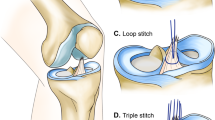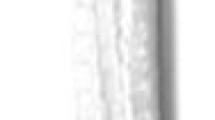Abstract
Purpose
The purpose of this study was to evaluate in a sheep model the biomechanical performance of augmented and nonaugmented primary repair of the anterior cruciate ligament (ACL) following transection at the femoral end during a 12-month postoperative observation.
Methods
Forty sheep were randomly assigned to nonaugmented or augmented primary ACL repair using a polyethylene terephthalate (PET) band. At two, six, 16, 26 and 52 weeks postoperatively four sheep in each group were sacrificed and biomechanical testing performed.
Results
Compared with nonaugmented primary ACL repair, the PET-augmented repair demonstrated superior biomechanical results from 16 weeks postoperatively onwards in terms of anterioposterior (AP) laxity, tensile strength and ligament stiffness. The augmentation device works as a stress shield during the ligament healing process. The nonaugmented ACL repair also resulted in ligament healing, but the biomechanical properties were at a significantly lower level.
Conclusion
These results support the previously reported histological findings following augmented primary ACL repair. This animal study on the healing capacity of the ACL may provide some important contributions to how primary healing in certain types of ruptures can be achieved.
Clinical relevance
I




Similar content being viewed by others
References
Gluckert K, Kladny B, Bank-Schal A, Hofmann G (1992) MRI of the knee joint with a 3-D gradient echo sequence. Equivalent to diagnostic arthroscopy? Arch Orthop Trauma Surg 112:5–14
Rupp S, Kaltenkirchen N, Hopf T, Gleitz M (1995) Clinical relevance of tunnel position and interference screw location after replacement-plasty of the anterior cruciate ligament with a patellar ligament transplant. Unfallchirurg 98:650–654
Gerber C, Matter P (1983) Biomechanical analysis of the knee after rupture of the anterior cruciate ligament and its primary repair. An instant-centre analysis of function. J Bone Joint Surg 65B:391–399
Johansson H, Sjolander P, Sojka P (1991) A sensory role for the cruciate ligaments. Clin Orthop 268:161–178
Sjolander P, Johansson H, Sojka P, Rehnholm A (1989) Sensory nerve endings in the cat cruciate ligaments: a morphological investigation. Neurosci Lett 102:33–38
Barrack RL, Bruckner JD, Kneisl J, Inman WS, Alexander AH (1990) The outcome of nonoperatively treated complete tears of the anterior cruciate ligament in active young adults. Clin Orthop 259:192–199
Andersson C, Gillquist J (1992) Treatment of acute isolated and combined ruptures of the anterior cruciate ligament. A long-term follow-up study. Am J Sports Med 20:7–12
Andersson C, Odensten M, Good L, Gillquist J (1989) Surgical or nonsurgical treatment of acute rupture of the anterior cruciate ligament. A randomized study with long-term follow-up. J Bone Joint Surg 71A:965–974
Engstrom B, Gornitzka J, Johansson C, Wredmark T (1993) Knee function after anterior cruciate ligament ruptures treated conservatevely. Int Orthop 17:208–213
Radford WJ, Amis AA, Heatley FW (1994) Immediate strength after suture of a torn anterior cruciate ligament. J Bone Joint Surg 76B:480–484
Barber FA, Small NC, Click J (1991) Anterior cruciate ligament reconstruction by semitendinosus and gracilis tendon autograft. Am J Knee Surg 4:84–93
Callaway GH, Nicholas SJ, Cavanaugh J, Warren RF, Wickiewicz TL (1995) Hamstring augmentation versus patella tendon reconstruction of acute ACL tears: a randomized, prospective study. Orthop Trans 19:250–255
Clancy WG Jr, Nelson DA, Reider B, Narechania RG (1982) Anterior cruciate ligament reconstruction using one-third of the patellar ligament, augmented by extra-articular tendon transfers. J Bone Joint Surg 64A:352–359
Grana MA, Hines R (1992) Arthroscopic-assisted semitendinosus reconstruction of the anterior cruciate ligament. Am J Knee Surg 5:16–22
Richter M, Duerselen L, Ignatius A, Missler F, Claes L (1997) Acutely repaired proximal anterior cruciate ligament ruptures in sheep—by augmentation improved stability and reduction of cartilage damage. J Mat Sci 8:855–859
Shelbourne KD, Klootwyk TE, Wilckens JH, De Carlo MS (1995) Ligament stability two to six years after anterior cruciate ligament reconstruction with autogenous patellar tendon graft and participation in accelerated rehabilitation program. Am J Sports Med 23:575–579
Chambat P, Guier C, Sonnery-Cottet B, Fayard JM, Thaunat M (2013) The evolution of ACL reconstruction over the last fifty years. Int Orthop 37:181–186
Dejour D, Vanconcelos W, Bonin N, Saggin PRF (2013) Comparative study between mono-bundle bone-patellar tendon-bone, double-bundle hamstring and mono-bundle bone-patellar tendon-bone combined with a modified Lemaire extra-articular procedure in anterior cruciate ligament reconstruction. Int Orthop 37:193–199
Amiel D, Kleiner JB, Roux RD, Haarwood FL, Akeson WH (1986) The phenomen of “ligamentization”: anterior cruciate ligament reconstruction with autogenous patellar tendon. J Orthop Res 4:162–172
Barrett DS (1991) Proprioception and function after anterior cruciate reconstruction. J Bone Joint Surg 73B:833–837
Seitz H, Menth-Chiari WA, Lang S, Nau T (2008) Histological evaluation of the healing potential of the anterior cruciate ligament by means of augmented and nonaugmented repair: an in vivo animal study. Knee Surg Sports Traumatol Arthrosc 16:1087–1093
Vavken P, Fleming BC, Mastrangelo AN, Machan JT, Murray MM (2012) Biomechanical outcomes after bioenhanced anterior cruciate ligament repair and anterior cruciate ligament reconstruction are equal in a porcine model. Arthroscopy 28:672–680
Struewer J, Ziring E, Frangen TM, Efe T, Meissner S et al (2013) Clinical outcome and prevalence of osteoarthritis after isolated anterior cruciate ligament reconstruction using hamstring graft: follow-up after two and ten years. Int Orthop 37:271–277
Mastrangelo AN, Haus BM, Vavken P, Palmer MP, Machan JT, Murray MM (2010) Immature animals have higher cellular density in the healing anterior cruciate ligament than adolescent or adult animals. J Orthop Res 28:1100–1106
Mastrangelo AN, Magarian EM, Palmer MP, Vavken P, Murray MM (2010) The effect of skeletal maturity on the regenerative function of intrinsic ACL cells. J Orthop Res 28:644–651
Murray MM, Magarian EM, Harrison SL, Mastrangelo AN, Zurakowski D, Fleming BC (2010) The effect of skeletal maturity on functional healing of the anterior cruciate ligament. J Bone Joint Surg Am 92:2039–2049
Murray MM (2009) Current status and potential of primary ACL repair. Clin Sports Med 28:51–61
Fruensgaard S, Kroner K, Riis J (1992) Suture of the torn anterior cruciate ligament. 5-year follow-up of 60 cases using an instrumental stability test. Acta Orthop Scand 63:323–325
Genelin F, Trost A, Primavesi C, Knoll P (1993) Late results following proximal reinsertion of isolated ruptured ACL ligaments. Knee Surg Sports Traumatol Arthroscop 1:17–19
Biedert RM, Stauffer E, Friedrich NF (1992) Occurrence of free nerve endings in the soft tissue of the knee joint. A histologic investigation. Am J Sports Med 20:430–433
Boynton MD, Fadale PD (1993) The basic science of anterior cruciate ligament injury. Orthop Rev 22:673–679
Elmqvist LG, Lorentzon R, Johansson C, Fugl-Meyer AR (1988) Does a torn anterior cruciate ligament lead to change in the central nervous drive of the knee extensors? Eur J Appl Physiol Occup Physiol 58:203–207
Giffin JR, Harner CD (2001) Failed anterior cruciate ligament surgery: overview of the problem. Am J Knee Surg 14:185–192
Marshall JL, Warren RF, Wickiewicz TL, Reider B (1979) The anterior cruciate ligament: a technique of repair and reconstruction. Clin Orthop 143:97–106
Grontvedt T, Engebretsen L, Benum P, Fasting O, Molster A, Strand T (1996) A prospective, randomized study of three operations for acute rupture of the anterior cruciate ligament. Five-year follow-up of one hundred and thirty-one patients. J Bone Joint Surg Am 78:159–168
Christen B, Jakob RP (1992) Fractures associated with patellar ligament grafts in cruciate ligament surgery. J Bone Joint Surg 74B:617–619
Stapleton TR (1997) Complications in anterior cruciate ligament reconstructions with patellar tendon grafts. Sports Med 5:156–162
Vergis A, Gillquist J (1995) Graft failure in intra-articular anterior cruciate ligament reconstruction: a review of the literature. Arthroscopy 11:312–321
Murray MM, Martin SD, Martin TL, Spector M (2000) Histological changes in the human anterior cruciate ligament after rupture. J Bone Joint Surg 82A:1387–1397
Ng GY, Oakes BW, McLean ID, Deacon OW, Lampard D (1996) The long-term biomechanical and viscoelastic performance of repairing anterior cruciate ligament after hemitransection in a goat model. Am J Sports Med 24:109–117
Seitz H, Marlovits S, Schwendenwein I, Muller E, Vecsei V (1998) Biocompatibility of polyethylene terephthalate (Trevira hochfest) augmentation device in repair of the anterior cruciate ligament. Biomaterials 19:189–196
Takahashi Y, Tabata Y (2004) Effect of the fiber diameter and porosity of nonwoven PET fabrics on the osteogenic differentiation of mesenchymal stem cells. J Biomater Sci Polymer Edn 15:41–57
Takamoto T, Hiraoka Y, Tabata Y (2007) Enhanced proliferation and osteogenic differentiation of rat mesenchymal stem cells in collagene sponge reinforced with different polyethylene terephtalate fibers. J Biomater Sci polymer Edn 18:865–881
Vavken P, Murray MM (2011) The potential for primary repair of the ACL. Sports Med Arthrosc 19:44–49
Vavken P, Saad FA, Murray MM (2010) Age dependence of expression of growth factor receptors in porcine ACL fibroblasts. J Orthop Res 28:1107–1112
Acknowledgments
The study was funded by the Austrian Research Fund (P09827-MED) and the Scientific Fund of the Major of Vienna.
Conflict of interest
None.
Author information
Authors and Affiliations
Corresponding author
Rights and permissions
About this article
Cite this article
Seitz, H., Pichl, W., Matzi, V. et al. Biomechanical evaluation of augmented and nonaugmented primary repair of the anterior cruciate ligament: an in vivo animal study. International Orthopaedics (SICOT) 37, 2305–2311 (2013). https://doi.org/10.1007/s00264-013-2098-8
Received:
Accepted:
Published:
Issue Date:
DOI: https://doi.org/10.1007/s00264-013-2098-8




